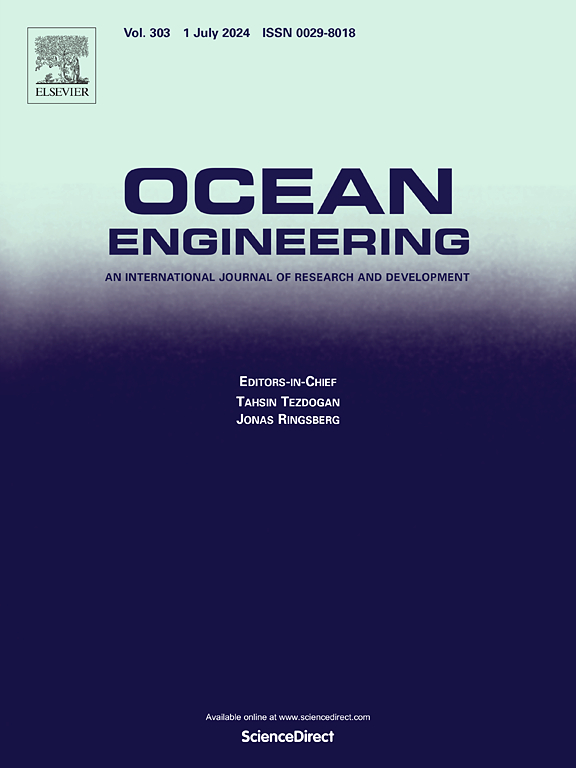Influence of twisted rudder on propeller line spectrum noise and rudder control force in submarines
IF 4.6
2区 工程技术
Q1 ENGINEERING, CIVIL
引用次数: 0
Abstract
As a new vibration and noise reduction measure, the twisted rudder in submarines improves propeller propulsion efficiency and reduces propeller excitation force. To fully understand the performance of the twisted rudder, the control force and propeller cavitation performance under small rudder angles were investigated. The propeller surface pressure pulsation was taken as a dipole sound source, and the low-frequency linear spectrum sound of the submarine propellers with conventional and twisted rudders under small rudder angles was numerically predicted employing an acoustic analogy method. The results showed that the twisted rudder improved the steering maneuverability and was beneficial for improving the cavitation performance of the propeller. The twisted rudder significantly reduced the main blade-passing frequency sound pressure level (1BPF SPL) of the propeller noise, which can reduce the average value of the 1BPF SPL of all monitoring points in the XY and XZ plane by more than 3.963 and 11.872 dB under different rudder angles, respectively. The results also exhibited a correlation between the reduction effect of the 1BPF SPL of the propeller and the reduction effect of the 1BPF amplitude of the unsteady force coefficient. The results have important military application value for submarine propeller noise reduction.
扭曲舵对潜艇螺旋桨线谱噪声和舵控制力的影响
作为一种新型减振降噪措施,潜艇中的扭转舵可提高螺旋桨推进效率,降低螺旋桨激振力。为了充分了解扭曲舵的性能,研究了小舵角条件下的控制力和螺旋桨空化性能。以螺旋桨表面压力脉动为偶极声源,采用声学类比方法对传统舵和扭曲舵潜艇螺旋桨在小舵角条件下的低频线谱声进行了数值预测。结果表明,扭转舵提高了转向操纵性,有利于改善螺旋桨的气蚀性能。扭转舵明显降低了螺旋桨噪声的主叶片通过频率声压级(1BPF SPL),在不同舵角下,可使 XY 和 XZ 平面上所有监测点的 1BPF SPL 平均值分别降低 3.963 和 11.872 dB 以上。结果还显示,螺旋桨 1BPF SPL 的降低效果与不稳定力系数 1BPF 振幅的降低效果之间存在相关性。这些结果对潜艇螺旋桨降噪具有重要的军事应用价值。
本文章由计算机程序翻译,如有差异,请以英文原文为准。
求助全文
约1分钟内获得全文
求助全文
来源期刊

Ocean Engineering
工程技术-工程:大洋
CiteScore
7.30
自引率
34.00%
发文量
2379
审稿时长
8.1 months
期刊介绍:
Ocean Engineering provides a medium for the publication of original research and development work in the field of ocean engineering. Ocean Engineering seeks papers in the following topics.
 求助内容:
求助内容: 应助结果提醒方式:
应助结果提醒方式:


